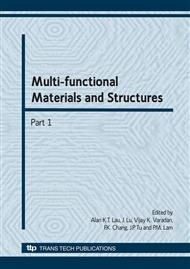p.1286
p.1290
p.1294
p.1298
p.1302
p.1307
p.1311
p.1315
p.1319
Surface Morphological Changes Accompanying Dissolution of Bioactive Glass: Effect of Residual Stress
Abstract:
We report our observations concerning the time evolution of surface morphology occurring during the in vitro immersion of bioactive glass surfaces in contact with phosphate buffer solution. We compare regions under intentionally produced residual stresses via micro-indentation to those where no indentation was performed. The sign of the residual stress is shown to be important for predicting dissolution behaviour; compression retards dissolution, whereas tension enhances dissolution. We analyze our results with a simple model for the work of bond dissociation. We report that a highly constrained residual compressive stress state, such as in an indent, leads to a work deficit in comparison to tension, which accounts for the slower dissolution rate of compressed bioactive glass. Such a mechanochemical effect suggests that the presence of residual stresses from the manufacture of biomedical implants and devices could lead to accelerated or delayed dissolution and that careful control of residual stresses should be sought for predictable performance in dissolvable materials.
Info:
Periodical:
Pages:
1302-1306
Citation:
Online since:
June 2008
Authors:
Price:
Сopyright:
© 2008 Trans Tech Publications Ltd. All Rights Reserved
Share:
Citation:


